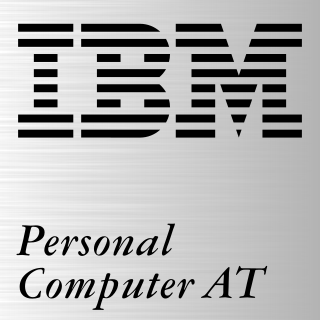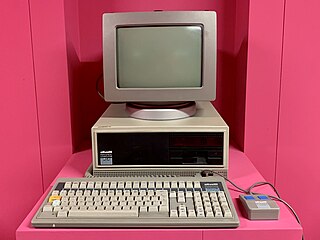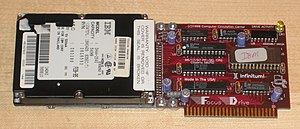
Industry Standard Architecture (ISA) is the 16-bit internal bus of IBM PC/AT and similar computers based on the Intel 80286 and its immediate successors during the 1980s. The bus was (largely) backward compatible with the 8-bit bus of the 8088-based IBM PC, including the IBM PC/XT as well as IBM PC compatibles.

The Tandy 1000 is the first in a line of IBM PC compatible home computer systems produced by the Tandy Corporation for sale in its Radio Shack and Radio Shack Computer Center chains of stores. Introduced in 1984, the product line was aimed at providing affordable but capable systems for home computing or education, with some of its Tandy specific features like graphics, sound and joystick port making it more appealing for home use.

In computing, an expansion card is a printed circuit board that can be inserted into an electrical connector, or expansion slot on a computer's motherboard to add functionality to a computer system. Sometimes the design of the computer's case and motherboard involves placing most of these slots onto a separate, removable card. Typically such cards are referred to as a riser card in part because they project upward from the board and allow expansion cards to be placed above and parallel to the motherboard.

CompactFlash (CF) is a flash memory mass storage device used mainly in portable electronic devices. The format was specified and the devices were first manufactured by SanDisk in 1994.

The IBM Personal Computer AT was released in 1984 as the fourth model in the IBM Personal Computer line, following the IBM PC/XT and its IBM Portable PC variant. It was designed around the Intel 80286 microprocessor.

The Microdrive is a type of miniature, 1-inch hard disk produced by IBM and Hitachi. These rotational media storage devices were designed to fit in CompactFlash (CF) Type II slots.
Pertec Computer Corporation (PCC), formerly Peripheral Equipment Corporation (PEC), was a computer company based in Chatsworth, California which originally designed and manufactured peripherals such as floppy drives, tape drives, instrumentation control and other hardware for computers.

The Compaq Portable II is the fourth product in the Compaq Portable series to be brought out by Compaq Computer Corporation. Released in 1986 at a price of US$3499, the Portable II much improved upon its predecessor, the Compaq 286, which had been Compaq's version of the PC AT in the original Compaq Portable chassis; Portable 286 came equipped with 6/8-MHz 286 and a high-speed 20-MB hard drive, while the Portable II included an 8 MHz processor, and was lighter and smaller than the previous Compaq Portables. There were four models of the Compaq Portable II. The basic Model 1 shipped one 5.25" floppy drive and 256 KB of RAM. The Model 2 added a second 5.25" floppy drive and sold for $3599. The Model 3 shipped with a 10MB hard disk in addition to one 5.25" floppy drive and 640 KB of RAM for $4799 at launch. The Model 4 would upgrade the Model 3 with a 20MB hard drive and sold for $4999. There also may have been a 4.1 MB hard drive included at one point. The Compaq Portable II was significantly lighter than its predecessors, the Model 1 weighed just 23.6 pounds compared to the 30.5 pounds the Compaq Portable 286 weighed. Compaq only shipped the system with a small demo disk, MS-DOS 3.1 had to be purchased separately.

The IBM 3270 PC, is a personal computer developed by IBM and released in October 1983. Although its hardware is mostly identical to the IBM PC XT, the 3270 contains additional components that, in combination with software, can emulate the behavior of an IBM 3270 terminal. Therefore, it can be used both as a standalone computer, and as a terminal to a mainframe.

In 1953, IBM recognized the immediate application for what it termed a "Random Access File" having high capacity and rapid random access at a relatively low cost. After considering technologies such as wire matrices, rod arrays, drums, drum arrays, etc., the engineers at IBM's San Jose California laboratory invented the hard disk drive. The disk drive created a new level in the computer data hierarchy, then termed Random Access Storage but today known as secondary storage, less expensive and slower than main memory but faster and more expensive than tape drives.
The Commodore PC compatible systems are a range of IBM PC compatible personal computers introduced in 1984 by home computer manufacturer Commodore Business Machines.

The Olivetti M24 is a computer that was sold by Olivetti in 1983 using the Intel 8086 CPU.

Altos Computer Systems was founded in 1977 by David G. Jackson and Roger William Vass Sr. It focused on small multi-user computers, starting with multi-user derivatives of CP/M, and later including Unix and Xenix-based machines. In its 1982 initial public offering on NASDAQ, the company raised $59M. Thereafter the company's stock was traded under the symbol ALTO.
A legacy-free PC is a type of personal computer that lacks a floppy or optical disc drive, legacy ports, and an Industry Standard Architecture (ISA) bus. According to Microsoft, "The basic goal for these requirements is that the operating system, devices, and end users cannot detect the presence of the following: ISA slots or devices; legacy floppy disk controller (FDC); and PS/2, serial, parallel, and game ports." The legacy ports are usually replaced with Universal Serial Bus (USB) ports. A USB adapter may be used if an older device must be connected to a PC lacking these ports. According to the 2001 edition of Microsoft's PC System Design Guide, a legacy-free PC must be able to boot from a USB device.

Plus Development Corporation was a majority-owned subsidiary of Quantum Corporation. The company invented the Hardcard, a hard disk drive on an expansion card, which started a wave of companies producing similar products in the 1980s.

The IBM Personal Computer XT is the second computer in the IBM Personal Computer line, released on March 8, 1983. Except for the addition of a built-in hard drive and extra expansion slots, it is very similar to the original IBM PC model 5150 from 1981.

The PS/1 is a brand for a line of personal computers that marked IBM's return to the home market in 1990, five years after the IBM PCjr. It was replaced by the IBM Aptiva in September 1994.

The Olivetti M20 is a Zilog Z8000 based computer designed and released by Olivetti in 1982. Although it offered good performance, it suffered from a lack of software due to its use of the Z8000 processor and custom operating system, PCOS. The company introduced the IBM PC compatible Olivetti M24 in 1983 and the M20 line was phased out.
The Tandy 3000 is a personal computer introduced by Radio Shack in 1986 based on the 16-bit 8 MHz Intel 80286 microprocessor.

Mountain Computer, Inc. was a privately held American computer peripheral manufacturer active as an independent company from 1977 to 1988. In its early years, the company chiefly developed products for the Apple II, including sound synthesizers, samplers, and hard disk and tape drives. Mountain also produced floppy disk duplicators for enterprise use. In the mid-1980s Mountain pivoted to focusing on products for the IBM Personal Computer and compatibles. In late 1988, the company was acquired by Nakamichi.



















